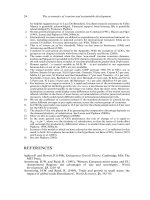THE ECONOMICS OF MONEY,BANKING, AND FINANCIAL MARKETS 361
Bạn đang xem bản rút gọn của tài liệu. Xem và tải ngay bản đầy đủ của tài liệu tại đây (40.79 KB, 1 trang )
CHAPTER 13
A PP LI CATI O N
Banking and the Management of Financial Institutions
329
Strategies for Managing Bank Capital
Suppose that as the manager of the First Bank, you have to make decisions about the
appropriate amount of bank capital. Looking at the balance sheet of the bank, which
like the High Capital Bank has a ratio of bank capital to assets of 10% ($10 million of
capital and $100 million of assets), you are concerned that the large amount of bank
capital is causing the return on equity to be too low. You conclude that the bank has
a capital surplus and should increase the equity multiplier to increase the return on
equity. What should you do?
To lower the amount of capital relative to assets and raise the equity multiplier, you can do any of three things: (1) you can reduce the amount of bank
capital by buying back some of the bank s stock; (2) you can reduce the bank s
capital by paying out higher dividends to its stockholders, thereby reducing the
bank s retained earnings; (3) you can keep bank capital constant but increase
the bank s assets by acquiring new funds, say, by issuing CDs, and then seeking
out loan business or purchasing more securities with these new funds. Because
you think that it would enhance your position with the stockholders, you decide
to pursue the second alternative and raise the dividend on the First Bank stock.
Now suppose that the First Bank is in a similar situation to the Low Capital
Bank and has a ratio of bank capital to assets of 4%. You now worry that the bank
is short on capital relative to assets because it does not have a sufficient cushion
to prevent bank failure. To raise the amount of capital relative to assets, you now
have the following three choices: (1) you can raise capital for the bank by having it issue equity (common stock); (2) you can raise capital by reducing the
bank s dividends to shareholders, thereby increasing retained earnings that it can
put into its capital account; (3) you can keep capital at the same level but reduce
the bank s assets by making fewer loans or by selling off securities and then using
the proceeds to reduce its liabilities. Suppose that raising bank capital is not easy
to do at the current time because capital markets are tight or because shareholders will protest if their dividends are cut. Then you might have to choose the third
alternative and decide to shrink the size of the bank.
In the aftermath of the subprime mortgage crisis in the United States, many
banks experienced capital shortfalls and had to restrict asset growth, as you might
have had to do if the First Bank were short of capital. The important consequences
of this for the credit markets are discussed in the Application that follows.
A PP LI CATI O N
How a Capital Crunch Caused a Credit Crunch in 2008
In the wake of the financial crisis of 2007 2008, there occurred a dramatic slowdown in the growth of credit, triggered by a credit crunch in which credit was
hard to get, and as a result the performance of the economy in 2008 and 2009 was
very poor. What caused the credit crunch?
Our analysis of how a bank manages bank capital explains why a credit crunch
occurred in 2008 and that it was caused, at least in part, by the capital crunch, in
which shortfalls of bank capital led to slower credit growth.









